Last updated: April 28, 2022
When making jerky one of the most important parts of the process is slicing the meat. This process can be a pain in the butt if you don’t have the right tools, and even worse when you have a blunt inefficient knife.
It pays to use a really sharp knife when slicing through tough budget cuts of meat typically used when making beef jerky. The best way to get a sharp knife is by using a good knife sharpener.
So what Knife Sharpener is the best?
There are quite a few different types of knife sharpeners on the market today. The most popular are listed below
- Single stage manual sharpener
- Three stage manual sharpener
- Electric sharpeners
- Sharpening stone
In this article we will review a range of sharpeners readily available on the market today.
BEST KNIFE SHARPENER TO BUY in 2022:
- Toplus Knife Sharpener – Professional Kitchen 3 Stage Knife Sharpener:
- Global 550/GB Ceramic Water Sharpener Knife Sharpener, Multicolored
- Davis & Waddell Essentials Electric Knife Sharpener for Kitchen Knives and Scissors 2 Grind Settings Fine Coarse
- Chef’s Choice 120 Diamond Hone 3-Stage Professional Knife Sharpener, Red
- CARVER MARVEL Kitchen Knife Sharpener – Professional 3 Stage Kitchen Sharpener
COMPARISONS OF THE BEST KNIFE SHARPENER FOR AUSTRALIA
| Model | Model # | Overall Rating | Style | Review | |
|---|---|---|---|---|---|
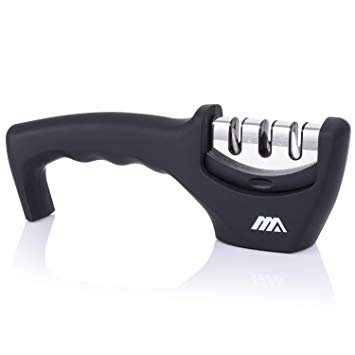 | Toplus Knife Sharpener - Professional Kitchen 3 Stage Knife Sharpener | Manual | Toplus Knife Sharpener Review | CHECK PRICE | |
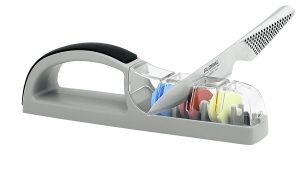 | Global 550/GB Ceramic Water Sharpener Knife Sharpener, Multicolored | Manual | Global 550 Review | CHECK PRICE | |
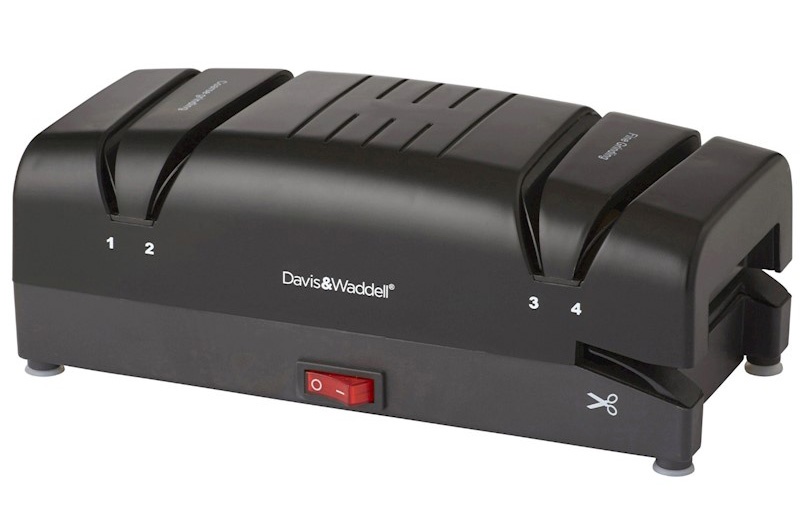 | Davis & Waddell Essentials Electric Knife Sharpener for Kitchen Knives and Scissors 2 Grind Settings Fine Coarse | Electric | Davis & Waddell Review | CHECK PRICE | |
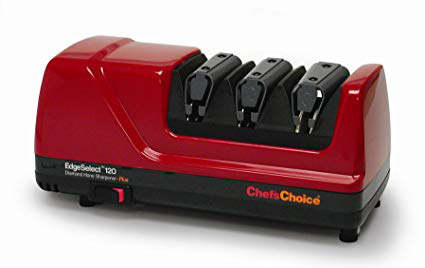 | Chef's Choice 120 Diamond Hone 3-Stage Professional Knife Sharpener, Red | Electric | Chef's Choice Review | CHECK PRICE | |
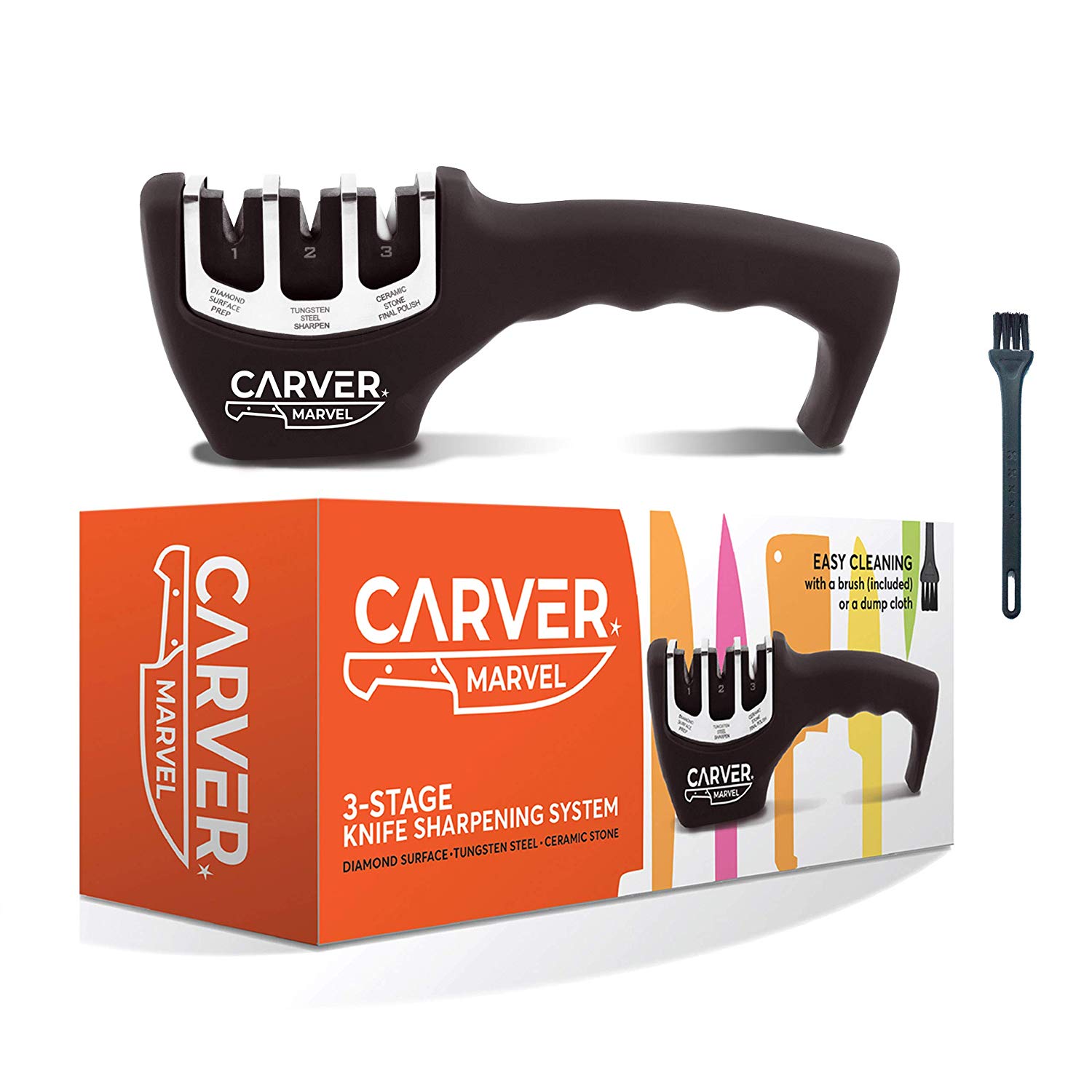 | CARVER MARVEL Kitchen Knife Sharpener - Professional 3 Stage Kitchen Sharpener | Manual | Carver Marvel Review | CHECK PRICE |
Matt, Owner of Bigwig Jerky Co.

OUR BEST KNIFE SHARPENER REVIEWS [2022]
Toplus Knife Sharpener – Professional Kitchen 3 Stage Knife Sharpener
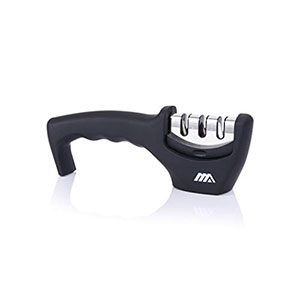
The Toplus Knife Sharpener comes with a three-stage sharpening system to file your knives as quickly and effectively as possible. The V-shaped metal points work well against dull blades of any kind for full restoration to their intended function. If the blade is dull, damaged, or has burrs, this knife sharpener can handle it.
The sharpening system grinds and polishes the blades of your knives. For convenience and safety, the knife sharpener has an ergonomic, non-slip handle that fits comfortably and safely into your hand, whether you are left or right-handed. The non-slip handle keeps it steady in your grip and prevents accidental injury, which means you can use it quickly without worry.
For more reliable cleaning, the grinder head can be removed. This unique feature also aids in storage consideration. The knife sharpener is light and small, which makes it more convenient to find somewhere to store it, too.
The best feature of this Toplus Knife Sharpener is its one-year warranty. If you are unsatisfied or it breaks within a year of purchase, it will be replaced or fully refunded.
Global 550/GB Ceramic Water Sharpener Knife Sharpener, Multicolored
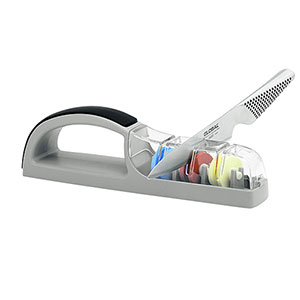
The ceramic knife sharpener uses innovative water sharpening technology to restore knives to their original, working condition. Using three ceramic wheels—coarse, medium, and fine—there is an option for sharpening any kind of knife you could own. While this knife sharpener is recommended for use with the GLOBAL brand knives, it will work on any knife you own.
The water concept takes effect while you sharpen. You fill the water compartment with liquid before you start grinding, and as you file your knives, the water washes your blades clean, cooling them down through the sharpening process. Feeding your knife through the sharpener seven or eight times will make them as good as new.
The GLOBAL is a handheld knife sharpener that has a grip handle for safe operation. The handle is secure with a soft rubber-like insert so that your hand does not get tired from holding the sharpener. The feature also prevents it from sliding away and causing an injury.
While this ceramic water sharpener comes at a higher price point, it is extremely effective.
Davis & Waddell Essentials Electric Knife Sharpener for Kitchen Knives and Scissors 2 Grind Settings Fine Coarse
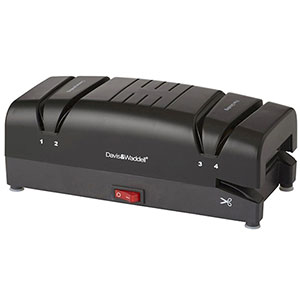
This knife sharpener is an excellent countertop component that is safe and easy to use. It comes with two grind settings—coarse and fine—for sharpening your knives and restoring them to their original state in seconds.
This trendy knife sharpener works on more than just knives, too. It has a slot for scissors, and even works well on screwdrivers.
Since this knife sharpener sits on the counter, it is safer to use than a handheld knife sharpener because it won’t accidentally slip out of your hand or drop onto things. To make it even more secure, the feet that touch the countertop are non-slip.
There are removable drawers to collect the fine dust that comes off the knives and aid in cleaning. To clean it, remove and empty the drawers and then wipe the equipment down with a damp cloth.
This knife sharpener is powered by a 60-watt motor that has overheat protection. Even if you use it for a long time, you don’t have to worry about the motor failing.
Besides all the safety features on this versatile knife sharpener, it also comes with a 12-month warranty. If anything goes wrong with this knife sharpener in 12 months, it will be replaced.
Chef’s Choice 120 Diamond Hone 3-Stage Professional Knife Sharpener
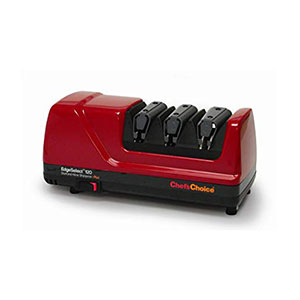
This classic chef’s knife sharpener is a professional level tool that can sharpen any knife you own. It works on all knives, including chef knives, butcher knives, sporting knives, and even serrated blades. This electric knife sharpener uses three stages and a precision angle control for Trizor-Plus edges—for a sharpness that the brand claims is “hairsplitting.”
In stages 1 and 2, this knife sharpener uses 100-per cent diamond abrasives for restoring your blades. In stage 3, it uses stropping and polishing to get it as sharp as possible. A noteworthy feature is that this knife sharpener uses no sharpening oils or liquids, so it takes minimal maintenance. It relies on the diamond hone aspect for optimal performance that is built into the design.
The device is safe to use as it is fixed directly onto the countertop. It won’t slip out of your hands or onto the floor. It even has elastomer feet that hold it securely in place for a secure experience.
While this electric knife sharpener is rather expensive, it comes with a limited three-year warranty. You know it is rugged enough to withstand anything that you could put it through.
CARVER MARVEL Kitchen Knife Sharpener – Professional 3 Stage Kitchen Sharpener
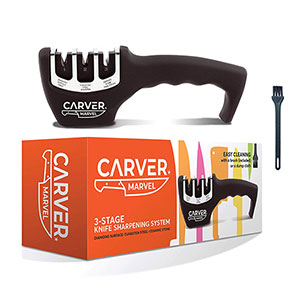
This handheld knife sharpener includes three different stages to ensure your knife will remain as sharp as the day you bought it.
- Stage one is a coarse diamond surface, which prepares your knives for sharpening.
- Stage two is a tungsten steel slot that does the actual sharpening.
- Stage three is a ceramic stone slot that polishes your knives for a fine when they are sharp.
All three stages are suitable for steel knives, while stages one and three are suitable for ceramic knives. CARVER MARVEL claims that it can sharpen knives in only thirty seconds, and it stands by its promise.
While this knife sharpener works on several different kinds of knives, it does not work on serrated knives.
For safety, this knife sharpener has an ergonomic handle that is easy to hold and includes an anti-slip rubber base that keeps it from slipping away from you. This knife sharpener also works well for both left and right-handed people. For easy cleaning, it comes with a cleaning brush so you can easily brush off any dust that accumulates.
To ensure that you are satisfied with your knife sharpener, it comes with a lifetime warranty.
HOW TO CHOOSE THE BEST KNIFE SHARPENER [BUYER’S GUIDE]
HOW A KNIFE SHARPENER WORKS
TYPES OF KNIFE SHARPENERS
KNIFE TYPES
POPULAR QUESTIONS ABOUT KNIFE SHARPENERS
Q. HOW OFTEN DOES A KNIFE NEED SHARPENING?
Q. HOW MUCH DOES KNIFE SHARPENING COST?
Q. DO KNIFE SHARPENERS WEAR OUT?
Q. AT WHAT DEGREE SHOULD A KNIFE BE SHARPENED?

OUR #1 KNIFE SHARPENER
TOPLUS KNIFE SHARPENER – PROFESSIONAL KITCHEN 3 STAGE KNIFE SHARPENER

